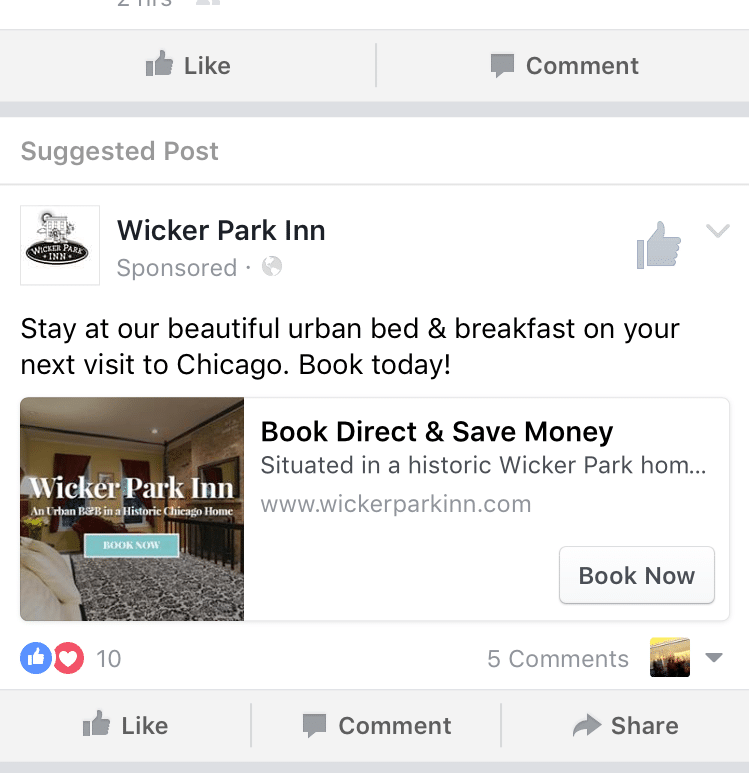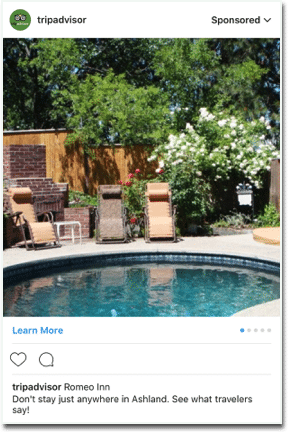If you are doing things right, traffic to your site is strong and growing. People are visiting your site, and many of those people may book a stay at your property as a result. But what about the visitors that don’t? Don't throw in the towel just because a visitor left your site without making a booking. Perhaps these potential guests left your site to do more research or are currently deciding among a few options. We call these Abandoned Bookings, but you can "recapture" those bookings with a strong retargeting ad campaign.
Retargeting ads are a tremendous way to capitalize on the traffic you are already bringing to your site. Retargeting ads encourage these potential guests to make a direct booking on your site once they have left it.
You’ve likely seen these types of ads yourself. Maybe those expensive shoes you were looking at online keep appearing on your Facebook feed or that dream trip to Mexico you considered booking keeps tantalizing you from Instagram. These ads seem to follow you around the internet, coaxing you to give a second thought to the very thing you passed up last time.
You can do this with your hotel marketing too!
Example of a retargeting ad in the wild:
Retargeting ads can show up on Facebook and Instagram as well.
How Retargeting Advertising Works
Here’s how it works. Someone visits your site but leaves without making a booking. Later on, when that same person is browsing online using their computer, phone or tablet, they see your ad. Your ad “recaptures” their interest, and inspires them to return to your site and book a stay. Retargeting allows you to reach customers all across the web using all types of devices. You will reconnect with travelers who showed initial interest in your property but maybe abandoned it the first time around.
Your retargeting ads follow potential guests away from your site and to other sites. This keeps your property in the forefront of their mind. If they are reading the news, clicking through their Facebook feed, scrolling through Instagram, or shopping online, your ad will appear and they will think: “Oh yes. I remember [Your Hotel]. Maybe I should make a reservation with them after all….”
Tip: Make sure your ads are clean, well-designed, and memorable. We recommend keeping it simple. Don’t crowd ads with too much written copy, use bold colors, and always include a call to action with big, clickable buttons.
Behavioral Targeting
Retargeting campaigns use the concept of Behavioral Targeting to entice a wide variety of potential guests. You can fine-tune your ad placement based on factors like age, gender, or geographical location. There are hundreds of different types of potential guests out there visiting countless different sites at any given moment in time. The reality is that one single ad, no matter how well it is designed, may be too generic to appeal to each potential guest. Retargeting allows you to deliver different ads tailored to a visitor’s actual behavior on your hotel’s website. For example, if a visitor was browsing your Spa page, targeted ads will then appear on beauty product websites or websites for yoga studios.
Furthermore, Audience Segmentation tools make it easy to tailor creative ads based on where and how the searcher was interacting with your site. If they were looking on your homepage, they might see more general ads for your property later on. If they were looking on your Spa page, they can see ads showcasing your spa services. And if they were browsing your Weddings page, they can see ads that play up your property as a wedding venue.
Another Tool to Beat out the OTAS
Beat OTAs at their own game. OTAs like Expedia and TripAdvisor also run retargeting campaigns for the people who saw YOUR listing on their website but didn’t book. This is yet another way an OTA can “steal’ direct bookings from you. They will drive people who are interested in your property back to THEIR OTA site. They do it because it works! Here is an example of an ad that appeared on a customer’s Instagram when they saw a hotel listing on TripAdvisor.
This is an example of a TripAdvisor retargeting ad that will direct someone back to TripAdvisor. You may still get the booking of course, but you’ll have to pay a commission to the OTA.
Tips for a Successful Retargeting Campaign
- Try a Frequency Cap: It is good to keep your brand in front of potential guests while they are searching, but be wary of OVER-EXPOSURE. You don’t want potential guests to get sick of seeing your ads or property name. They might start to ignore the ads completely or even form negative associations with them. We recommend employing a Frequency Cap. This allows you to limit the number of times a tagged user will see your ads.
- Use a Burn Code: Burn Codes prevent searchers who have already booked a stay at your property from seeing your ads. By continuing to serve ads to converted guests, you run the risk of annoying them AND wasting money on guests who have already decided to book a stay.
- Rotate your Ads: Let’s say you designed a particularly creative, eye-catching, and memorable ad that dramatically boosts your click-through rate. You will be tempted to keep running that high performing ad forever. Don’t. According to research, click-through rates drop by up to 50% if you run the same set of ads for longer than six months. Rotate your ads every few months so they continue to stand out and attract searchers’ attention.
Retargeting is an easy and cost-effective digital marketing strategy. Don’t lose potential guests just because they clicked away from your site. Use retargeting ads to keep your property in the forefront of searchers’ minds and entice them back to your site to make a booking.
PS: If you are an Odysys customer, we offer retargeting advertising as a service via our “Reservation Recapture” program.




